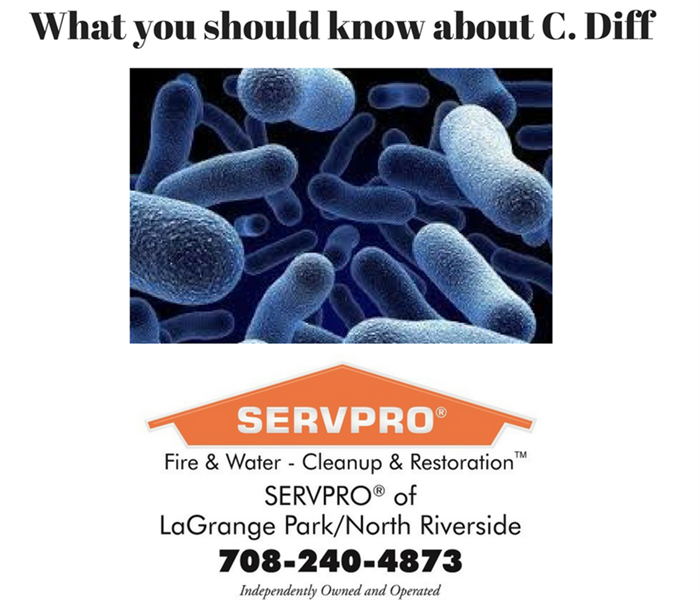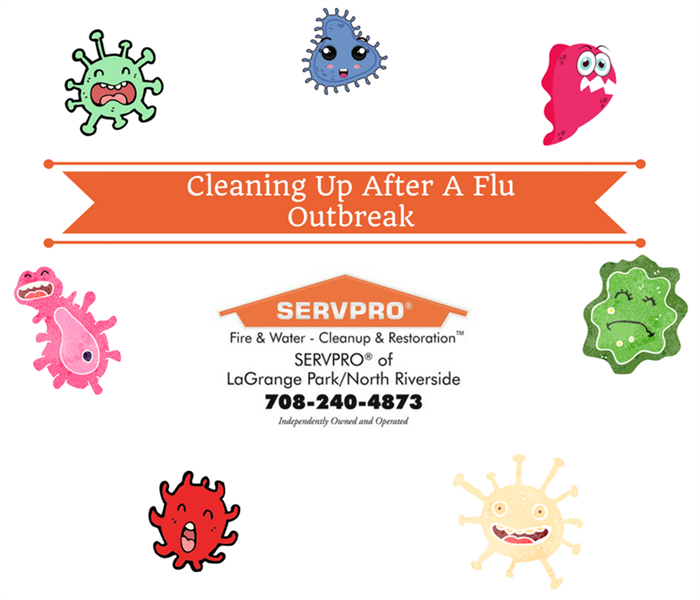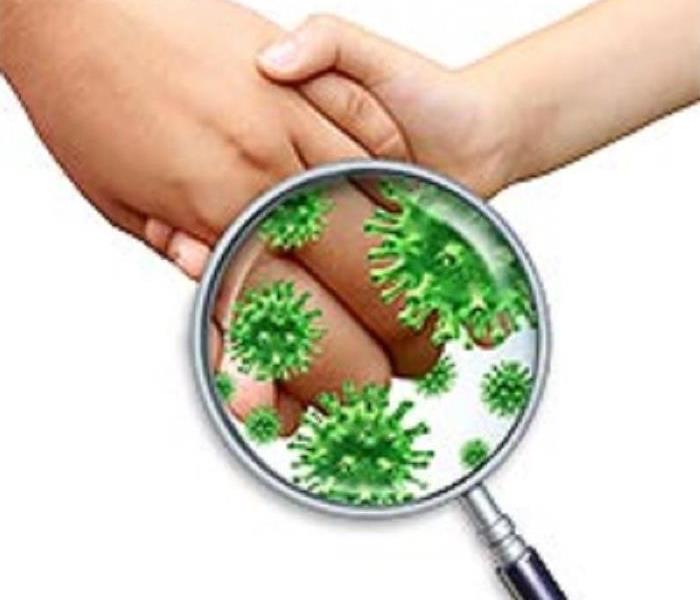What you should know about C. Diff
4/16/2018 (Permalink)
According to Mayo Clinic “when something upsets the balance of these organisms in your gut, otherwise harmless bacteria can grow out of control and make you sick. One of the worst offenders is a bacterium called Clostridium difficile (C. difficile, or C. diff). As the bacteria overgrow they release toxins that attack the lining of the intestines, causing a condition called Clostridium difficilecolitis.” C. diff is one of the most important causes of infectious diarrhea in the U.S. according to the CDC.
How Does It Spread?
- diff is found in feces and is transmitted by touch. If you come into contact with an infected surface, then touch your mouth or nose, the disease can enter your body through the mucous membranes. It can also be passed by touching an infected person, which is part of why it is so prevalent in healthcare settings or in places where sick people are common. People with compromised immune systems, including the elderly, are at an increased risk of catching this illness.
About 50 percent of the population naturally carries clostridium difficile (C. diff) in their intestines. The bacteria, C. diff, exists within the body in a vegetative state and doesn’t make people sick, unless illness, disease and antibiotic use puts them at risk.
What To Do If Someone You Know Has Contracted C. Diff?
The most important part and first thing you should do is get medical attention for the person with symptoms of having C. Diff. Then protect the rest of your home and prevent any reinfection by having your home thoroughly cleaned by a professional biohazard service like SERVPRO of LaGrange Park/North Riverside. This precaution is especially important if the ill person shares a bathroom with others, or if there are small children or elderly in the home. Even if surfaces like faucets and sinks appear clean, c. Difficile can be incredibly resistant to household cleaners and disinfectants. A traditional house cleaning may not be enough to defeat the illness.
“Studies have shown that out of all the surfaces that must be cleaned in a hospital room, only 39 percent will actually be cleaned by housekeepers,” Benjamin Tanner, president of Antimicrobial Test Laboratories. Using a professional service like SERVPRO of LaGrange Park/North Riverside, we are trained and use specialty equipment and environmentally green products to clean and disinfect the areas that have come in contact with the bacteria.
As with all of your commercial and home cleaning needs, we are here to help. We are “faster to any size disaster”. Call us at 708-240-4873, for an appointment.
Cleaning Up After A Flu Outbreak
3/6/2018 (Permalink)
Disinfecting should be part of your usual cleaning routine, whether or not anyone at home is sick. Disinfecting your home on a regular basis will help limit the number of days that people in your household get sick with a cold or flu.
Check the labels on your cleaning supplies to make sure the disinfectant works against the viruses you're targeting, such as cold and flu viruses. When you use disinfectant sprays, paper towels are better than sponges, but disposable disinfectant wipes have an advantage. Sponges and cloth tend to spread the germs around, however the disposable wipes you wet the surface and allow the area to dry. This also allows for more of the germs to be contained.
According to Center for Hygiene and Health in Home and Community, there are 7 major areas of your home to focus on disinfecting.
- Your phone. Eighty percent of phones in homes that have a child with the flu have the flu virus on them. That can include cell phones and land lines. Cold and flu viruses survive on them, anywhere from a few hours to a few days.
- The remote control. It's one of the most touched -- and least cleaned -- items in your house
- The bathroom. Half of all bathroom faucets have cold and flu viruses when someone has a cold or flu. Give the sick person their own hand towel, to avoid spreading disease through a shared towel.
- Kitchen tables, coffee tables, play-area tables, and night tables tend to host cold and flu viruses, because they're touched often and aren't wiped down enough.
- Check the maker's instructions before cleaning. You may be able to wipe keyboards or screens with an alcohol wipe or a paper towel sprayed with disinfectant.
- Stuffed animals. If possible, toss Teddy in the laundry. If it's not washable, keep it away from everyone for a few days to let viruses on its surface die.
- Sheets, blankets, towels. "These should be washed at high temperature with a color-safe bleach detergent. Wash your hands after handling them.
Here’s to helping keep your family a little less likely to catching the flu bug or nasty cold. Here at SERVPRO of LaGrange Park/North Riverside, we are always here to help.
How to clean up after exposure to MRSA
3/27/2017 (Permalink)
Let’s start off with the question, what is MRSA? According to Mayo Clinic, it is an infection caused by a type of staph bacteria that's become resistant to many of the antibiotics used to treat ordinary staph infections. There are two distinct types of MRSA, HA-MRSA and CA-MRSA.
HA-MRSA occur in people who have been in a hospital setting, nursing home, or dialysis centers. HA-MRSA is typically found in those patients that have undergone an invasive procedure, had artificial joints implanted, or have intravenous tubing. Hospitalized patients taking antibiotics that lower the normal flora levels gives the MRSA virus the advantage. Whereas patients in hospitals have breaks in their skin (surgical wounds, intravenous lines (IVs), and catheters) that can allow bacteria to enter underlying tissues or the bloodstream, according to MN Health Department.
CA-MRSA is occurs in the general healthy public, and often begins as a painful skin boil. According to the Mayo Clinic, it is spread by skin-to-skin contact. At-risk populations include groups such as high school wrestlers, child care workers and people who live in crowded conditions. Studies done at Mayo Clinic found that those with CA-MRSA tend to be younger, school aged patients.
Cleaning up after MRSA, the EPA has found that spraying or fogging rooms or surfaces with disinfectants will prevent MRSA infections more effectively than the targeted approach of cleaning frequently touched surfaces and any surfaces that have been exposed to infections. “Shared equipment that comes into direct skin contact should be cleaned after each use and allowed to dry. Equipment, such as helmets and protective gear, should be cleaned according to the equipment manufacturers’ instructions to make sure the cleaner will not harm the item.” Center of Disease Control
Laundry items should be washed on very hot temperatures. Bleach should also be used if possible. These items should also be laundered separately to keep the infection for spreading. The CDC recommends washing bed linens daily until the infection is gone. Avoiding having someone in bed with the infected person will also lower the chance of the infection spreading.
The best way to prevent the spread of MRSA is to have all affected areas cleaned. Prevention for HA-MRSA, according to the Mayo Clinic, the patients are quarantined, visitors and staff are required to wear protective garments and must follow strict hand hygiene procedures. Contaminated surfaces and laundry items are to be properly disinfected daily.
Those that come in contact with HA-MRSA, according to the CDC can do the following to prevent the spread of the infection:
- Wash your hands. Careful hand washing remains your best defense against germs. Scrub hands briskly for at least 15 seconds, then dry them with a disposable towel and use another towel to turn off the faucet. Carry a small bottle of hand sanitizer containing at least 62 percent alcohol for times when you don't have access to soap and water.
- Keep wounds covered.Keep cuts and abrasions clean and covered with sterile, dry bandages until they heal. The pus from infected sores may contain MRSA, and keeping wounds covered will help prevent the bacteria from spreading.
- Keep personal items personal.Avoid sharing personal items such as towels, sheets, razors, clothing and athletic equipment. MRSA spreads on contaminated objects as well as through direct contact.
- Shower after athletic games or practices.Shower immediately after each game or practice. Use soap and water. Don't share towels.
- Sanitize linens.If you have a cut or sore, wash towels and bed linens in a washing machine set to the hottest water setting (with added bleach, if possible) and dry them in a hot dryer. Wash gym and athletic clothes after each wearing.
SERVPRO of LaGrange Park/North Riverside provides cleaning at schools for mats, helmets, and other sports equipment that are often forgotten to sanitize. We also can come into your home and do a deep clean, sanitize, and fogging of all affected areas that may have come into contact with MRSA infection. Give us a call at 708-240-4873, and we will be happy to discuss how we can assist in your home, school, or business.






 24/7 Emergency Service
24/7 Emergency Service


